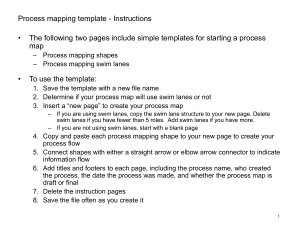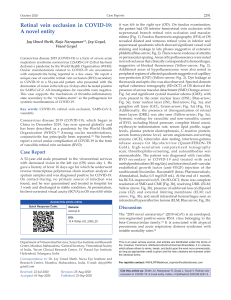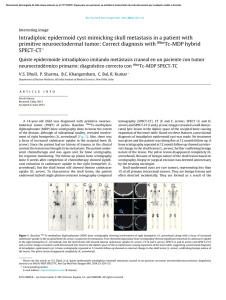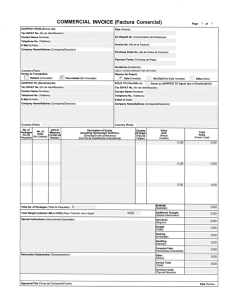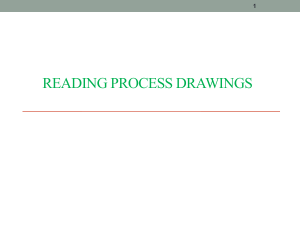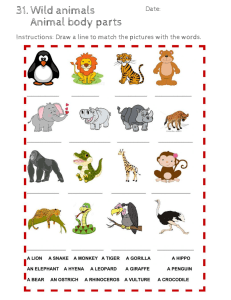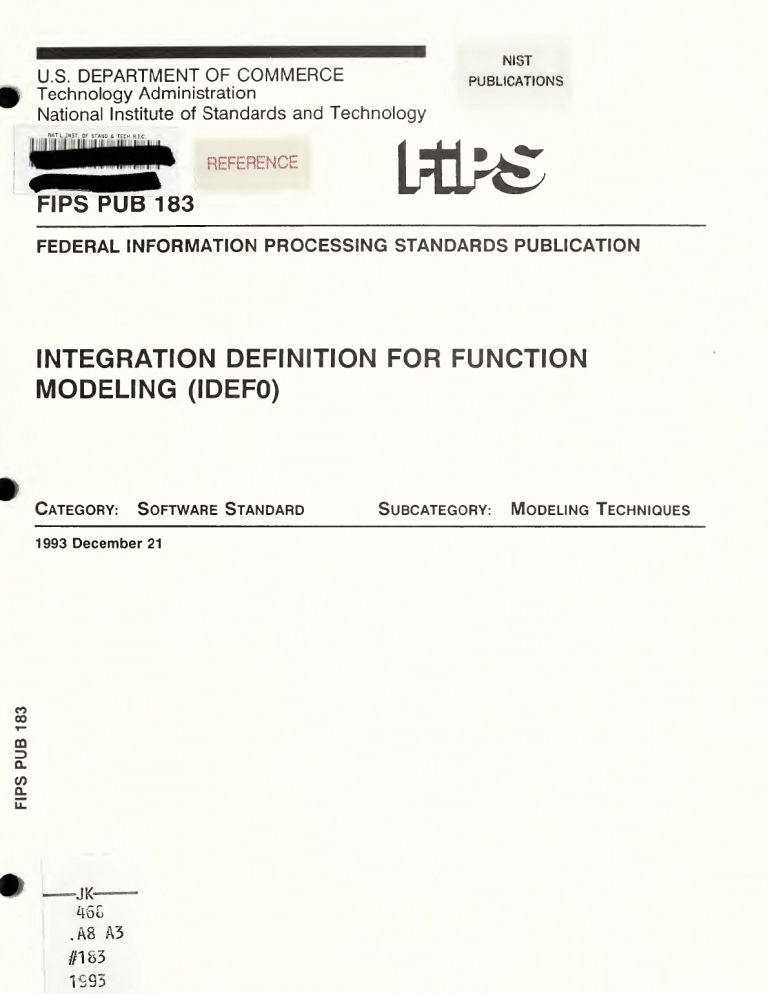
[—l — — U.S. DEPARTMENT OF COMMERCE NIST PUBLIC:TIONS Technology Administration National Institute of Standards and Technology [ mO & CH R ME —— CEE D, - FIPS PUB 183 FEDERAL INFORMATION PROCESSING STANDARDS PUBLICATION INTEGRATION DEFINITION FOR FUNCTION MODELING (IDEFO) CATEGORY: SOFTWARE FIPS PUB 183 1993 December 21 STANDARD SUBCATEGORY: MODELING TECHNIQUES FIPS PUB 183 FEDERAL INFORMATION PROCESSING STANDARDS PUBLICATION INTEGRATION DEFINITION FOR FUNCTION MODELING (IDEF0) CATEGORY: SOFTWARE STANDARD Computer Systems Laborawory National Institute of Standards and Technology Gaithersburg, MD 20899 Issued December 21, 1993 Srares 06 7 S U.S. Department of Commerce Ronald H. Brown, Secretary Technology Administration Mary L. Good, Under Secretary for Technology National Institute of Standards and Technology Arati Prabhakar, Director SUBCATEGORY: MODELING TECHNIQUES Foreword The Federal Information Processing Standards Publication Series of the National Institute of Standards and Technology (NIST) is the official publication relating to standards and guidelines adopted and promulgated under the provisions of Section 111(d) of the Federal Property and Administrative Services Act of 1949 as amended by the Computer Security Act of 1987, Public Law 100-235. These mandates have given the Secretary of Commerce and NIST important responsibilities for improving the utilization and management of computer and related telecommunications systems in the Federal Government. The NIST, through its Computer Systems Laboratory, provides leadership, technical guidance, and coordination of Government efforts in the development of standards and guidelines in these areas. Comments concerning Federal Information Processing Standards Publications are welcomed and should be addressed to the Director, Computer Systems Laboratory, National Institute of Standards and Technology, Gaithersburg, MD 20899. James H. Burrows, Director Computer Systems Laboratory Abstract The Integration Definition for Function Modeling (IDEF0) is based on the Air Force Wright Aeronautical Laboratories Integrated Computer-Aided Manufacturing (ICAM) Architecture, Part I, Volume 1V —Function Modeling Manual (IDEFO), June 1981. This standard describes the IDEFO modeling language (semantics and syntax), and associated rules and techniques, for developing structured graphical representations of a system or enterprise. Use of this standard permits the construction of models comprising system functions (activities, actions, processes, operations), functional relationships, and data (information or objects) that support systems integration. Key words: - activity model; business process improvement; business re-engineering; Federal Information Processing Standard (FIPS); function model; graphical language; IDEFO; modeling language. National Institute of Standards and Technology FIPS PUB 183 U.S. Government Printing Office Washington: 1993 For sale by the National Technical Information Service 95 pages (Dec. 21, 1993) U.S. CODEN: Springfield, VA 22161 FIPPAT Department of Commerce FIPS PUB 183 Federal Information Processing Standards Publication 183 1993 December 21 Announcing the Standard for INTEGRATION DEFINITION FOR FUNCTION MODELING (IDEF0) Federal Information Processing Standards Publications (FIPS PUBS) are issued by the National Institute of Standards and Technology (NIST) after approval by the Secretary of Commerce pursuant to Section 111(d) of the Federal Property and Administrative Services Act of 1949 as amended by the Computer Security Act of 1987, Public Law 100-235. 1. Name of Standard. Integration Definition for Function Modeling 2. Category of Standard. (IDEFO). Software Standard, Modeling Techniques. 3. Explanation. This publication announces the adoption of the Integration Definition for Function Modeling (IDEFO) as a Federal Information Processing Standard (FIPS). This standard is based on the Air Force Wright Aeronautical Laboratories Integrated Computer-Aided Manufacturing (ICAM) Architecture, Part I, Volume IV — Function Modeling Manual (IDEFO), June 1981. This standard describes the IDEFO modeling language (semantics and syntax), and associated rules and techniques, for developing structured graphical representations of a system or enterprise. Use of this standard permits the construction of models comprising system functions (activities, actions, processes, operations), functional relationships, and data (information or objects) that support systems integration. This standard is the reference authority for use by system or enterprise modelers required to utilize the IDEFO modeling technique, by implementors in developing tools for implementing this technique, and by other computer professionals in understanding the precise syntactic and semantic rules of the standard. 4. Approving Authority. Secretary of Commerce. 5. Maintenance Agency. Department of Commerce, National Institute of Standards and Technology, Computer Systems Laboratory. 6. Cross Index. a. ICAM Architecture Part II, Volume IV—Function Modeling Manual (IDEFO), AFWAL-TR-81-4023, Materials Laboratory, Air Force Wright Aeronautical Laboratories, Air Force Systems Command, WrightPatterson Air Force Base, Ohio 45433, June 1981. 7. Related Documents. a. Federal Information Resources Management Regulations Subpart 201.20.303, Standards, and Subpart 201.39.1002, Federal Standards. b. Integrated Information Support System Part 4 —Information Modeling Manual-IDEF1 C. (IISS), Volume V—Common Data Model Subsystem, Extended, December 1985. ICAM Architecture Part II, Volume V— Information Modeling Manual (IDEF1), AFWAL-TR-81-4023, Materials Laboratory, Air Force Wright Aeronautical Laboratories, Air Force Systems Command, Wright- Patterson Air Force Base, Ohio 45433, June 1981. d. ICAM Configuration Management, Volume Il —ICAM Documentation Standards for Systems Development Methodology (SDM), AFWAL-TR-82-4157, Air Force Systems Command, Wright-Patterson Air Force Base, Ohio 45433, October 1983. FIPS PUB 183 8. Objectives. The primary objectives of this standard are: a. To provide a means for completely and consistently modeling the functions (activities, actions, processes, operations) required by a system or enterprise, and the functional relationships and data (information or objects) that support the integration of those functions; b. To provide a modeling technique which is independent of Computer-Aided Software Engineering (CASE) c. or tcols, but which can be used in conjunction with those methods Generic (for analysis of systems of varying purpose, scope and complexity); — Rigorous and precise (for production of correct, usable models); — Concise — Conceptual (for representation of functional requirements rather than physical or organizational implementations); — Flexible (to support several phases of the life cycle of a project). (to facilitate understanding, communication, consensus and validation); Applicability. The use of this standard is strongly recommended a. or tools; To provide a modeling technique that has the following characteristics: — 9. methods for projects that: Require a modeling technique for the analysis, development, re-engineering, integration, or acquisition of information systems; b. Incorporate a systems or enterprise modeling technique into a business process analysis or soft- ware engineering methodology. The specifications of this standard are applicable when system or enterprise modeling techniques are applied to the following: a. Projects requiring IDEFO as the modeling technique; b. Development of automated software tools implementing the IDEFO modeling technique. The specifications of this standard are not applicable to those projects requiring a function modeling technique other than IDEFO. Nonstandard features of the IDEFO technique should be used only when the needed operation or function cannot reasonably be implemented with the standard features alone. Although nonstandard features can be very useful, it should be recognized that the use of these or any other nonstandard ele- ments may make the integration of models more difficult and costly. 10. Specifications. This standard adopts the Integration Federal Information Processing Standard (FIPS). 11. Definition for Function Modeling (IDEFO) as a Implementation. The implementation of this standard involves two areas of consideration: acquisition of implementations and interpretation of the standard. 11.1 Acquisition of IDEFO Implementations. This publication (FIPS 183) is effective June 30, 1994. For Federal acquisitions after this date, projects utilizing the IDEFO function modeling technique, or software implementing the IDEFO modeling technique, should conform to FIPS 183. Conformance to this standard should be considered whether the project or software utilizing the IDEFO modeling technique is acquired as part of an ADP system procurement, acquired by separate leasing arrangement, or specified for use in contracts for programming A transition period provides time for industry to develop products transition period begins on the effective date and continues for one (1) this publication apply to orders placed after the date of this publication; procurement, used services. conforming to this year thereafter. The however, utilizing a under an ADP standard. The provisions of function mod- eling technique that does not conform to this standard may be permitted during the transition period. FIPS PUB 183 11.2 Interpretation of this FIPS. NIST provides for the resolution of questions regarding the imple- mentation and applicability of this FIPS. All questions concerning the interpretation of this standard should be addressed to: Director, Computer Systems Laboratory ATTN: FIPS 183 Interpretation National Institute of Standards and Technology Gaithersburg, MD 20899 12. Waivers. Under certain exceptional circumstances, the heads of Federal departments and agencies may approve waivers to Federal Information Processing Standards (FIPS). The head of such agencies may redelegate such authority only to a senior official designated pursuant to section 3506(b) of Title 44, United States Code. Requests for waivers shall be granted only when: a. b. Compliance with a standard would adversely affect the accomplishment of the mission of an operator of a Federal computer system, or Compliance with a standard would cause a major adverse financial impact on the operator which is not offset by government-wide savings. Agency heads may approve requests for waivers only by a written decision which explains the basis upon which the agency head made the required finding(s). A copy of each such decision, with procurement sensitive or classified portions clearly identified, shall be sent to: Director, Computer ATTN: Systems Laboratory FIPS Waiver Decisions National Institute of Standards and Technology Gaithersburg, MD 20899 In addition, notice of each waiver granted and each delegation of authority to approve waivers shall be sent promptly to the Committee on Government Operations of the House of Representatives and the Committee on Governmental Affairs of the Senate and shall be published promptly in the Federal Register. When the determination on a waiver request applies to the procurement of equipment and/or services, a notice of the waiver determination must be published in the Commerce Business Daily as a part of the notice of solicitation for offers of an acquisition or, if the waiver determination is made after that notice is published, by amendment of such notice. A copy of the waiver reque<t, any supporting documents, the document approving the waiver request and any supporting and accompanying documents, with such deletions as the agency is authorized and decides to make under 5 U.S.C. Sec. 552 (b), shall be part of the procurement documentation and retained by the agency. 13. Where to Obtain Copies. Copies of this publication are for sale by the National Technical Information Service, U.S. Department of Commerce, Springfield, VA 22161. When ordering, refer to Federal Information Processing Standards Publication check, money order, or deposit account. 183 (FIPSPUB183) and title. Payment may be made by Federal Information Processing Standards Publication 183 Specification for Integration Definition for Function Modeling (IDEFO) Introduction: This standard is composed of normative and informative sections. Compliance with the normative sections (Sections 1 through 3) is required. The informative sections (Annexes A through D) provide additional suggestions and guidance. Compliance with the informative sections is not required to comply with the standard, unless such compliance is stipulated by an organization adopting this standard. This informative introduction discusses the background and approach of IDEFO (pronounced I-def zero). It provides the reader with an orientation and approach to the normative sections. Background: During the 1970s, the U.S. Air Force Program for Integrated Computer Aided Manufacturing (ICAM) sought to increase manufacturing productivity through systematic application of computer technology. The ICAM program identified the need for better analysis and communication techniques for people involved in improving manufacturing productivity. As a result, the ICAM program developed a series of techniques known as the IDEF (ICAM Definition) techniques which included the following: 1. IDEFO, used to produce a "function model". A function model is a structured representation of the functions, activities or processes within the modeled system or subject area. 2. IDEFI, used to produce an "information model". An information model represents the structure and semantics of information within the modeled system or subject area. 3. IDEF2, used to produce a "dynamics model". A dynamics model represents the time-varying behavioral characteristics of the modeled system or subject area. In 1983, the U.S. Air Force Integrated Information Support System program enhanced the IDEF1 information modeling technique to form IDEF1X (IDEF1 Extended), a semantic data modeling technique. Currently, IDEFO and IDEF1X techniques are widely used in the government, industrial and commercial sectors, supporting modeling efforts for a wide range of enterprises and application domains. In 1991 the National Institute of Standards and Technology (NIST) received support from the U.S. Department of Defense, Office of Corporate Information Management (DoD/CIM), to develop one or more Federal Information Processing Standards (FIPS) for modeling techniques. The techniques selected were IDEFO for function modeling and IDEF1X for information modeling. These FIPS documents are based on the IDEF manuals published by the U.S. Air Force in the early 1980s. The IDEFO Approach: IDEFO (Integration DEFinition language 0) is based on SADT™ (Structured Analysis and Design Technique™), developed by Douglas T. Ross and SofTech, Inc. In its original form, IDEFO includes both a definition of a graphical modeling language (syntax and semantics) and a description of a comprehensive methodology for developing models. IDEFO may be used to model a wide variety of automated and non-automated systems. For new systems, IDEFO may be used first to define the requirements and specify the functions, and then to design an implementation that meets the requirements and performs the functions. For existing systems, IDEFO can be used to analyze the functions the system performs and to record the mechanisms (means) by which these are done. The result of applying IDEFO to a system is a model that consists of a hierarchical series of diagrams, text, and glossary cross-referenced to each other. The two primary modeling components are functions (represented on a diagram by boxes) and the data and objects that inter-relate those functions (represented by arrows). As a function modeling language, IDEFO has the following characteristics: 1. It is comprehensive and expressive, capable of graphically representing a wide variety of business, manufacturing and other types of enterprise operations to any level of detail. 2. It is a coherent and simple language, providing for rigorous and precise expression, and promoting consistency of usage and interpretation. 3. It enhances communication between systems analysts, developers and users through ease of learning and its emphasis on hierarchical exposition of detail. 4. It is well-tested and proven, through many years of use in Air Force and other government development projects, and by private industry. 5. It can be generated by a variety of computer graphics tools; numerous commercial products specifically support development and analysis of IDEFO diagrams and models. In addition to definition of the IDEFO language, the IDEFO methodology also prescribes procedures and techniques for developing and interpreting models, including ones for data gathering, diagram construction, review cycles and documentation. Materials related solely to modeling procedures are presented in the informative annexes of this document. Table of Contents 1. Overview ... 1.1 Scop 1.2 Purpose.. ...l .1 de 2. Definitions...............=....vereveereveeree cccc e 2 3. IDEFO Models 5.9 3.1 3.2 Model Concepts . Syntax and Semantics 3.2.1 Syntax......... 3.2.1.1 Boxes. 3.2.1.2 Arrows... 3.2.1.3 Syntax Rules. 3.2.2 SemanticS................ 3.2.2.1 Box and Arrow Semantic 3.2.2.2 Labels and Names.............. 3.2.2.3 Box and Arrow Semantic Rules 5 .6 .6 .6 .6 CU 7 7 9 e 3.3 IDEFODiagrams .10 3.3.1 3.3.2 ...................... Types of Diagrams 1 Top-Level Context Diagram 2 Child Diagram.... 3 Parent Diagram 4 Text and Glossary ... 5 For Exposition Only Diagrams Diagram am Features .................. .1 Arrows as Constraints . .2 Activations of a Box .3 Concurrent Operation.. 4 Arrows as Pipelines . .5 Branching Arrows.. -6 Inter-Box Connections. .7 Boundary Arrows ........ .8 ICOM Coding of Boundary .9 Tunneled Arrows. .10 Call Arrows.. rO U)'u) 2 Node Numbers. 3.3.4.2.1 Node Inde 3.3.4.2.2 Node Tree. .3 Node References. .4 Model Notes.. 5 ReferenceNoLaLlon 3.4.1 3.4.2.2 3.4.3 IDEFO Model Description Context Diagrams............... High-Level Context Diagrams 3.4.4 FEOs, Text and Glossary. 3.4.5 3.4.6 Model Name........ Presentation Rules. .10 .10 11 ME 13 .14 .14 ANNEX/ACIDERO CONCEPTS*: 04500000000 h en e. — .Ne ae eer AN Es ee R A R ACE BackeroUnd: O A.2 IDEFO A.3 Discussion of Individual IDEFO Concepts. A.3.1 Activity Modeling Graphics ...... A.3.2 Communication by Gradual Exposition of Detail . A.3.3 Disciplined Teamwork | (Iesei E- Concepts... ANNEX B - CREATING AND INTERPRETING IDEFO DIAGRAMS .. Reading IDEFO Diagrams............... B.1.1 Approaching a Model B.1.2 Diagram Reading Steps ... B.1.3 Semantics of Boxes and Arrows. B.1.3.1 Constraints Omit How and When . B.1.3.2 Multiple Inputs, Controls and Outputs.. B.2 Author's Guide to Creating IDEFO Diagrams B.2.1 Basic Steps of Authoring ............ B.2.1.1 Selecting a Context, Viewpoint and Purpose. Al 2 Creating the Context Diagram.... ls 3 Creating the Top-Most Diagram . de 4 Creating Child Diagrams.. ae 5 Creating Supporting Material el 6 Selecting a Box to Detail .1. 7 Author Activities........... B.2. 1.7.1 Data Gathering Phase B.2. 1.7.2 Structuring Phase B.2. 1.7.3 Presentation Phase B.2. 1.7.4 Interaction Phase . B.2.2 ra ingan IDEFO Diagram. .1 Generating Functio .2 Creating Interface Arrows .3 Level of Effort............. rawmg an IDEFO Diagram. B.2.3 .1 Modifying Boxes.. .2 Bundling Arrows.. - Proposing Modifications to the Context 2. 4 ICOM Syntax for Connecting Diagrams raphic Layout.................eeme... B.2.4 .2.4.1 Constraints on the Diagram. .2.4.2 Arrow Placement .. .2.4.3 Arrow Layout B.2.5 ri ting Text ............. 2 5.1 Text and Glossary . 2. D 2 Notes and References.. B.3 Data Collection for IDEF Modeling . mwgwww owwww 7 oo W W o PRPERPRRE B.I B.3.1 B.3.2 B.3.3 Introduction............ The Interview Proces The Interview Kit iv . 31 ENPELADN. 31 ANNEX C - REVIEW CYCLE PROCEDURES AND FORMS ............................. 62 C.1 IDEF Teamwork Discipline... C.2 The IDEF C.2.1 C.2.2 Kit Cycle.. Personnel Roles.. C.2.1.1 Author. C.2.1.2 Commenter.. Guidelines for Authors and Readers and Commenters. C.2.2.1 Reader Guidelines .. C.2.2.2 Author/Commenter C.2.2.3 Meeting Guidelines C.3 IDEF Kits C.3.1 Completing a Kit Cover Sheet. C.3.2 How to Prepare a Standard Kit... C.4 Standard Diagram Form.. C.4.1 Working Informatio C.4.1.1 The “Author/Date/Project” Fiel C.4 1.2 The "Reader Notes" Field . [ 1.3 The “Status” Field....... C.4. 1.4 The “Reader/Date” Field C4. 1.5 The “Context” Field.. C.4.1.6 The “Used At” Fiel C.4.2 The “Message” Field .. C.4.3 C.4.4 C.4.5 The “Node” Field. The “Title” Field .. The “Number” Field C.4.5.1 The “Number” C.4.5.2 The “Number” Field (“Kit Page Number” Small Field (Large Area).. Rectangle Area).. C.5 Keeping Files.......................e0m0eneenereee re eee 75 C.6 The IDEF Model Walk-Through Procedure ......................000 0000000 75 ANNEX D - Informative Definitions..........................2 20000000000 79 1. Overview 1.1 Scope This standard describes the modeling language (syntax and semantics) which supports the IDEFO technique for developing structured graphical representations of a system or subject area. Use of this standard permits the construction of IDEFO models comprising system functions (actions, processes, operations), functional relationships, and the data and objects that support systems analysis and design, enterprise analysis, and business process re-engineering. This document provides three normative sections, Sections 1, 2 and 3, which define the language that supports IDEFO modeling. This section, Section 1, provides an overview of the document. Section 2 defines the key terms used in the normative sections. Section 3 defines the syntax and semantics of the language. In addition to the three normative sections, this document also provides four informative annexes. Annex A discusses the concepts that underlie IDEFO. Annex B provides guidelines for creating, interpreting and gathering data for IDEFO diagrams. Annex C describes structured team-oriented procedures (including forms) for IDEFO model review and validation. Annex D defines the key terms used in the annexes. This standard covers IDEFO as defined by the U.S. Air Force Integrated Computer-Aided Manufacturing (ICAM) Function Modeling Manual (IDEFO), June 1981, and commonly practiced by many IDEF users since then. 1.2 Purpose The primary objectives of this standard are: 1. To document and clarify the IDEFO modeling technique and how to correctly use it; 2. To provide a means for completely and consistently modeling the functions required by a system or subject area, and the data and objects that interrelate those functions; 3. To provide a modeling language which is independent of Computer-Aided Software Engineering (CASE) methods or tools, but which can be used in conjunction with those methods or tools; 4. To provide a modeling language that has the following characteristics: a) b) Generic (for analysis of systems and subject areas of varying purpose, scope and complexity); Rigorous and precise (for production of correct, usable models); c) Concise (to facilitate understanding, communication, consensus and validation); d) Conceptual (for representation of functional requirements independent of physical or organizational implementations); Flexible (to support several phases of the life cycle of a project). €) 2. Definitions This section contains definitions that relate to the normative sections of this document. Annex D for definitions for the informative annexes. See A term, if defined, is defined in either Section 2 or Annex D. 2.1 A-0 Diagram: The special case of a one-box IDEFO context diagram, containing the top-level function being modeled and its inputs, controls, outputs and mechanisms, along with statements of model purpose and viewpoint. 2.2 Arrow: A directed line, composed of one or more arrow segments, that models an open channel or conduit conveying data or objects from source (no arrowhead) to use (with arrowhead). There are 4 arrow classes: Input Arrow, Output Arrow, Control Arrow, and Mechanism Arrow (includes Call Arrow). Arrow. See Arrow Segment, Boundary Arrow, Internal 2.3 Arrow Label: A noun or noun phrase associated with an IDEFO arrow or arrow segment, specifying its meaning. 2.4 Arrow Segment: A line segment that originates or terminates at a box side, a branch (fork or join), or a boundary (unconnected end). 2.5 Boundary Arrow: box on a diagram. 2.6 An arrow with one end (source or use) not connected to any Contrast with Internal Arrow. Box: Arectangle, containing a name and number, used to represent a function. 2.7 Box Name: The verb or verb phrase placed inside an IDEFO box to describe the modeled function. 2.8 Box Number: The number (0 to 6) placed inside the lower right corner of an IDEFO box to uniquely identify the box on a diagram. 2.9 Branch: A junction (fork or join) of two or more arrow segments. 2.10 Bundling/Unbundling: The combining of arrow meanings into a composite meaning (bundling), or the separation of arrow meanings (unbundling), expressed by arrow join and fork syntax. 2.11 C-Number: A chronological creation number that may be used to uniquely identify a diagram and to trace its history; may be used as a Detail Reference Expression to specify a particular version of a diagram. 2.12 Call Arrow: A type of mechanism arrow that enables the sharing of detail between models (linking them together) or within a model. 2.13 Child Box: A box on a child diagram. 2.14 Child Diagram: The diagram that details a parent box. 2.15 Context: The immediate environment in which a function (or set of functions on a diagram) operates. 2.16 Context Diagram: A diagram that presents the context of a model, whose node number is A-n (n greater than or equal to zero). The one-box A-0 diagram is a required context diagram; those with node numbers A-1, A-2, ... are optional context diagrams. 2.17 Control Arrow: The class of arrows that express IDEFO Control, i.e., conditions required to produce correct output. Data or objects modeled as controls may be transformed by the function, creating output. Control arrows are associated with the top side of an IDEFO box. 2.18 Decomposition: functions. The partitioning of a modeled function into its component 2.19 Detail Reference Expression (DRE): A reference (e.g., node number, Cnumber, page number) written beneath the lower right corner of an IDEFO box to show that it is detailed and to indicate which diagram details it. 2.20 Diagram: A single unit of an IDEFO model that presents the details of a box. 2.21 Diagram Node Number: That part of a diagram's node reference that corresponds to its parent box node number. 2.22 For Exposition Only (FEO) Diagram: A graphic description used to expose or highlight specific facts about an IDEFO diagram. Unlike an IDEFO graphic diagram, a FEO diagram need not comply with IDEFO rules. 2.23 Fork: The junction at which an IDEFO arrow segment (going from source to use) divides into two or more arrow segments. May denote unbundling of meaning. 2.24 Function: An activity, process, or transformation (modeled by an IDEFO box) identified by a verb or verb phrase that describes what must be accomplished. 2.25 Function Name: Same as Box Name. 2.26 Glossary: A listing of definitions for key words, phrases and acronyms used in conjunction with an IDEFO node or model as a whole. 2.27 ICOM Code: The acronym of Input, Control, Output, Mechanism. A code that associates the boundary arrows of a child diagram with the arrows of its parent box; also used for reference purposes. 2.28 IDEFO Model: A graphic description of a system or subject that is developed for a specific purpose and from a selected viewpoint. A set of one or more IDEFO diagrams that depict the functions of a system or subject area with graphics, text and glossary. 2.29 Input Arrow: The class of arrows that express IDEFO Input, i.e., the data or objects that are transformed by the function into output. Input arrows are associated with the left side of an IDEFO box. 2.30 Interface: A shared boundary across which data or objects are passed; the connection between two or more model components for the purpose of passing data or objects from one to the other. 2.31 Internal Arrow: An input, control or output arrow connected at both ends (source and use) to a box on a diagram. Contrast with Boundary Arrow. 2.32 Join: The junction at which an IDEFO arrow segment (going from source to use) merges with one or more other arrow segments to form a single arrow segment. May denote bundling of arrow segment meanings. 2.33 Mechanism Arrow: The class of arrows that express IDEFO Mechanism, i.e., the means used to perform a function; includes the special case of Call Arrow. Mechanism arrows are associated with the bottom side of an IDEFO box. 2.34 Model Note: A textual comment that is part of an IDEFO diagram, used to record a fact not otherwise depicted. 2.35 Node: A box from which child boxes originate; a parent box. See Node Index, Node Tree, Node Number, Node Reference, Diagram Node Number. 2.36 Node Index: A listing, often indented, showing nodes in an IDEFO model "outline" order. Same meaning and content as Node Tree. in 2.37 Node Number: A code assigned to a box to specify its position in the model hierarchy; may be used as a Detail Reference Expression. 2.38 Node Reference: A code assigned to a diagram to identify it and specify its position in the model hierarchy; composed of the model name (abbreviated) and the diagram node number, with optional extensions. 2.39 Node Tree: The graphical representation of the parent-child relationships between the nodes of an IDEFO model, in the form of a graphical tree. Same meaning and content as Node Index. 2.40 Output Arrow: The class of arrows that express IDEFO Output, i.e., the data or objects produced by a function. Output arrows are associated with the right side of an TDEFO box. 2.41 Parent Box: A box that is detailed by a child diagram. 2.42 Parent Diagram: A diagram that contains a parent box. 2.43 Purpose: A brief statement of the reason for a model's existence. 2.44 Semantics: The meaning of the syntactic components of a language. 2.45 Squiggle: A small jagged line that may be used to associate a label with a particular arrow segment or to associate a model note with a component of a diagram. 2.46 Syntax: Structural components or features of a language and the rules that define relationships among them. 2.47 Text: An overall textual (non-graphical) comment about an IDEFO graphic diagram. 2.48 Title: A verb or verb phrase that describes the overall function presented on an IDEFO diagram; the title of a child diagram corresponds to its parent box name. 2.49 Tunneled Arrow: An arrow (with special notation) that does not follow the normal requirement that each arrow on a diagram must correspond to arrows on related parent and child diagrams. 2.50 Viewpoint: A brief statement of the perspective of the model. 4 3. IDEF0 Models This section discusses the basic elements of the IDEFO modeling technique, identifies the basic components of syntax (graphical component) and semantics (meaning), specifies the rules that govern the use of the IDEFO technique, and describes the types of diagrams used. Although the components of syntax and semantics are very highly interrelated, each one is discussed separately without regard for the actual sequence of construction. 3.1 Model Concepts A model is a representation of a set of components of a system or subject area. The model is developed for understanding, analysis, improvement or replacement of the system. Systems are composed of interfacing or interdependent parts that work together to perform a useful function. System parts can be any combination of things, including people, information, software, processes, equipment, products, or raw materials. The model describes what a system does, what controls it, what things it works on, what means it uses to perform its functions, and what it produces. IDEFO is a modeling technique based on combined graphics and text that are presented in an organized and systematic way to gain understanding, support analysis, provide logic for potential changes, specify requirements, or support systems level design and integration activities. An IDEFO model is composed of a hierarchical series of diagrams that gradually display increasing levels of detail describing functions and their interfaces within the context of a system. There are three types of diagrams: graphic, text, and glossary. The graphic diagrams define functions and functional relationships via box and arrow syntax and semantics. The text and glossary diagrams provide additional information in support of graphic diagrams. IDEFO is an engineering technique for performing and managing needs analysis, analysis, requirements definition, functional analysis, benefits systems design, maintenance, and baselines for continuous improvement. IDEFO models provide a "blueprint" of functions and their interfaces that must be captured and understood in order to make systems engineering decisions that are logical, affordable, integratable and achievable. The IDEFO model reflects how system functions interrelate and operate just as the blueprint of a product reflects how the different pieces of a product fit together. When used in a systematic way, IDEFO provides a systems engineering approach to: 1. Performing systems analysis and design at all levels, for systems composed of people, machines, materials, computers and information of all varieties the entire enterprise, a system, or a subject area; 2. Producing reference documentation concurrent with development to serve as a basis for integrating new systems or improving existing systems; 3. Communicating among analysts, designers, users, and managers; 4. Allowing coalition team consensus to be achieved by shared understanding; 5. Managing 6. Providing a reference architecture for enterprise analysis, information engineering and resource management. progress; large and complex projects using qualitative measures of Further discussion of concepts, philosophy, and roles for participants in IDEFO modeling projects is presented in the informative annexes of this document. 3.2 Syntax 3.2.1 and Semantics Syntax The structural components and features of a language and the rules that define relationships among them are referred to as the language's syntax. The components of the IDEFO syntax are boxes and arrows, rules, and diagrams. Boxes represent functions, defined as activities, processes or transformations. Arrows represent data or objects related to functions. Rules define how the components are used, and the diagrams provide a format for depicting models both verbally and graphically. The format also provides the basis for model configuration management. 3.2.1.1 Boxes A box provides a description of what happens in a designated shown in Figure 1. Each box shall have a name and number The name shall be an active verb or verb phrase that describes the diagram shall contain a box number inside the lower right used to identify the subject box in the associated text. * Function name is a verb or a verb phrase. DEVELOP MODEL 3.2.1.2 function. A typical box is inside the box boundaries. the function. Each box on corner. Box numbers are 1 * A box number is shown. Figure 1. Box Syntax Arrows An arrow is composed of one or more line segments, with a terminal arrowhead at one end. As shown in Figure 2, arrow segments may be straight or curved (with a 90° arc connecting horizontal and vertical parts), and may have branching (forking or joining) configurations. Arrows do not represent flow or sequence as in the traditional process flow model. Arrows convey data or objects related to functions to be performed. The functions receiving data or objects are constrained by the data or objects made available. — - * Straight line arrow segment * Curved arrow segment; corners are rounded with 90 degree arcs i * Forking arrows * Joining arrows Figure 3.2.1.3 Syntax 2. Arrow Syntax Rules Boxes 1. Boxes shall be sufficient in size to insert box name. 2. 3. Boxes shall be rectangular in shape, with square corners. Boxes shall be drawn with solid lines. Arrows 3.2.2 1. Arrows that bend shall be curved using only 90 degree arcs. 2. Arrows shall be drawn in solid line segments. 3 Arrows shall be drawn vertically or horizontally, not diagonally. 4. Arrow ends shall touch the outer perimeter of the function box and shall not cross into the box. 5. Arrows shall attach at box sides, not at corners. Semantics Semantics refers to the meaning of syntactic components of a language and aids correctness of interpretation. Interpretation addresses items such as box and arrow notation and functional relationship interfaces. 3.2.2.1 Box and Arrow Semantics Since IDEFO supports function modeling, the box name shall be a verb or verb phrase, such as “Perform Inspection”, that is descriptive of the function that the box represents. The example "Perform Inspection” function transforms uninspected parts into inspected 7 parts. The definitive step beyond the phrase-naming of the box is the incorporation of arrows (matching the orientation of the box sides) that complement and complete the expressive power (as distinguished from the representational aspect) of the IDEFO box. Standard terminology shall be used to ensure precise communication. Box meanings are named—descriptively—with verbs or verb phrases and are split and clustered in decomposition diagramming. Arrow meanings are bundled and unbundled in diagramming and the arrow segments are labeled with nouns or noun phrases to express meanings. Arrow-segment labels are prescriptive, constraining the meaning of their segment to apply exclusively to the particular data or objects that the arrow segment graphically represents. Arrow meanings are further expressed through fork and join syntax. Each side of the function box has a standard meaning in terms of box/arrow relationships. The side of the box with which an arrow interfaces reflects the arrow's role. Arrows entering the left side of the box are inputs. Inputs are transformed or consumed by the function to produce outputs. Arrows entering the box on the top are controls. Controls specify the conditions required for the function to produce correct outputs. Arrows leaving a box on the right side are outputs. Outputs are the data or objects produced by the function. Arrows connected to the bottom side of the box represent mechanisms. Upward pointing arrows identify some of the means that support the execution of the function. Other means may be inherited from the parent box. Mechanism arrows that point downward are call arrows. Call arrows enable the sharing of detail between models (linking them together) or between portions of the same model. The called box provides detail for the caller box (see Section 3.3.2.10). Standard arrow positions are shown in Figure 3. Supporting information concerning the function and its purpose shall be addressed in the text associated with the diagram. A diagram may or may not have associated text. When acronyms, abbreviations, key words, or phrases are used, the fully defined term(s) shall be provided in the glossary. Control | Input —— = FUNCTION NAME — E Mechanism Figure 3. Arrow — Call Positions and Roles Output 3.2.2.2 Labels and Names Boxes represent functions that show what must be accomplished. A function name shall be an active verb or verb phrase, such as: process parts monitor performance develop detail design plan resources design system fabricate component conduct review provide maintenance inspect part The arrows identify data or objects needed or produced by the function. Each arrow shall be labeled with a noun or noun phrase, such as: specifications design requirements test report detail design budget directive design engineer board assembly requirements An example depicting the placement of arrow labels and box names is shown in Figure 4. Design Requirements Recommended Detailed Design Ne Preliminary Design Data — PERFORM DETAILED DESIGN m 1 ¢ MEG/A631 Design Engineer Figure 3.2.2.3 Box and Arrow 4. Label Semantic and Name Semantics Rules 1. A box shall be named with an active verb or verb phrase. 2. Each side of a function box shall have a standard box/arrow relationship: a) Input arrows shall interface with the left side of a box. b) c) Control arrows shall interface with the top side of a box. Output arrows shall interface with the right side of the box. d) Mechanism arrows (except call arrows) shall point upward and shall connect to the bottom side of the box. e) Mechanism call arrows shall point downward, shall connect to the bottom side of the box, and shall be labeled with the reference expression for the box which details the subject box. 3 Arrow segments, except for call arrows, shall be labeled with a noun or noun phrase unless a single arrow label clearly applies to the arrow as a whole. 4. A “squiggle” (= ) shall be used to link an arrow with its associated label, unless the arrow/label relationship is obvious. 5. Arrow labels shall not consist solely of any of the following function, terms: input, control, output, mechanism, or call. 3.3 IDEFO Diagrams 3.3.1 Types of Diagrams TDEFO models are composed of three types of information: graphic diagrams, text, and glossary. These diagram types are cross-referenced to each other. The graphic diagram is the major component of an IDEFO model, containing boxes, arrows, box/arrow interconnections and associated relationships. Boxes represent each major function of a subject. These functions are broken down or decomposed into more detailed diagrams, until the subject is described at a level necessary to support the goals of a particular project. The top-level diagram in the model provides the most general or abstract description of the subject represented by the model. This diagram is followed by a series of child diagrams providing more detail about the subject. 3.3.1.1 Top-Level Context Diagram Each model shall have a top-level context diagram, on which the subject of the model is represented by a single box with its bounding arrows. This is called the A-0 diagram (pronounced A minus zero). The arrows on this diagram interface with functions outside the subject area to establish model focus. Since a single box represents the whole subject, the descriptive name written in the box is general. The same is true of the interface arrows since they also represent the complete set of external interfaces to the subject. The A-0 diagram also sets the model scope or boundary and orientation. An example A-0 diagram is shown in Figure 5. The A-0 context diagram also shall present brief statements specifying the model's viewpoint and purpose, which help to guide and constrain the creation of the model. The viewpoint determines what can be "seen" within the model context, and from what perspective or "slant". Depending on the audience, different statements of viewpoint may be adopted that emphasize different aspects of the subject. Things that are important in one viewpoint may not even appear in a model presented from another viewpoint of the same subject. The statement of purpose expresses the reason why the model is created and actually determines the structure of the model. The most important features come first in the hierarchy, as the whole top-level function is decomposed into sub-function parts that compose it, and those parts, in turn, are further decomposed until all of the relevant detail of the whole viewpoint is adequately exposed. Each sub-function is modeled individually by a box, with parent boxes detailed by child diagrams at the next lower level. All child diagrams must be within the scope of the top-level context diagram. 10 ' Program Charter Issues —— ENE INFORMATION Operations PROGRAM F Program Plan Data Program Team PURPOSE: The assessment, planning, and streamlining of information management functions. VIEWPOINT: The Information Integration Assessment Team. QA/A-0 MANAGE INFORMATION RESOURCES Figure 3.3.1.2 Child 5. Example Top-level Diagram Diagram The single function represented on the top-level context diagram may be decomposed into its major sub-functions by creating its child diagram. In turn, each of these sub-functions may be decomposed, each creating another, lower-level child diagram. On a given diagram, some of the functions, none of the functions or all of the functions may be decomposed. Each child diagram contains the child boxes and arrows that provide additional detail about the parent box. The child diagram that results from the decomposition of a function covers the same scope as the parent box it details. Thus, a child diagram may be thought of as being the "inside" of its parent box. This structure is illustrated in Figure 6. 3.3.1.3 Parent Diagram A parent diagram is one that contains one or more parent boxes. Every ordinary (noncontext) diagram is also a child diagram, since by definition it details a parent box. Thus a diagram may be both a parent diagram (containing parent boxes) and a child diagram (detailing its own parent box). Likewise, a box may be both a parent box (detailed by a child diagram) and a child box (appearing on a child diagram). The primary hierarchical relationship is between a parent box and the child diagram that details it. — — | - E T A¢, P ! — , PA - 1 PE E A0 7 - I ’ ‘¢’ ’ — , , — ) ! 1 More General , - E 2 3|-] " X AD | , , More Detailed aa R T - This box is the parent of this diagram. — 1 / , , — ttic AT ] H Figure ' NOTE: been detailed. The C-number or page number of the child diagram could have been used instead of the node number. | 6. Decomposition Node numbers shown here indicate that the box has Structure The fact that a child box is detailed, and is therefore also a parent box, is indicated by the presence of a Detail Reference Expression (DRE). The DRE is a short code written below the lower right corner of the detailed (parent) box that points to its child diagram. The DRE shall take one of the following forms: 1. A chronological creation number called a "C-number" that shall uniquely identify a particular version of a child diagram. A page number of the child diagram in the published document in which the model appears. The node number referencing the child diagram. If there are multiple versions of a child diagram, a particular version cannot be specified. A model note number whose text specifies ths conditions for selection of a particular child version. Figure 7 illustrates the use of node numbers as DREs. In the figure, the presence of DREs under boxes 1, 2 and 3 indicates that they have been detailed on the specified child diagrams. e c a — i = A6 = Ol } — p = 02 2 A612 n — A = 03 Xa ' J 4l — 04 E Mi MEG/A61 | T Figure 3.3.1.4 Text A diagram may and have 7. Detail Reference Expression Use Glossary associated overview of the diagram. structured text, which is used to provide a concise Text shall be used to highlight features, flows, and inter-box 13 connections to clarify the intent of items and patterns considered to be of significance. Text shall not be used merely to describe, redundantly, the meaning of boxes and arrows. The glossary shall be used to define acronyms and key words and phrases that have been used in conjunction with diagram graphics. The glossary defines words in the model that must convey a common understanding in order to correctly interpret the model content. 3.3.1.5 For Exposition Only Diagrams For Exposition Only (FEO, pronounced fee-oh) diagrams shall be used where an additional level of supplementary knowledge is required to adequately understand specific areas of a model. Supplementary detailing should be limited to what is needed to achieve the stated purpose for a knowledgeable audience. A FEO diagram need not comply with IDEFO syntax rules. 3.3.2 3.3.2.1 Diagram Arrows Features as Constraints Arrows on an IDEFO diagram represent data or objects as constraints. Only at low levels of detail can arrows represent flow or sequence, when the modeled subject is sufficiently detailed to treat specific changes made to specific data items or objects. Connecting the output of one box to the input, control, or mechanism of another box shows that the function modeled by the latter box requires, and thus is constrained by, the presence of the corresponding output of the former box. This type of constraint is illustrated in Figure 8. The arrows connecting to a box represent all the data and objects that are needed for the function to be completely performed. ...and this data/object provided by function 1. Performance of function 3 requires this data/object output from function 2... Figure 3.3.2.2 Activations 8. Meaning of Constraint of a Box A box may perform various parts of its function under different circumstances, using different combinations of its input and controls and producing different outputs. These different performances are called the different activations of the box.

